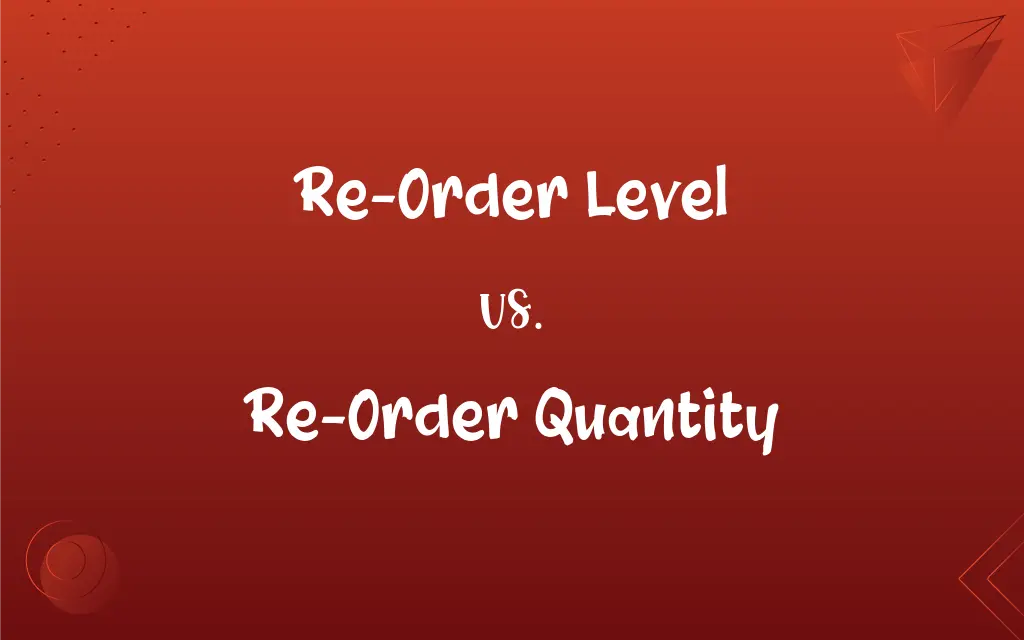Re-Order Level vs. Re-Order Quantity: What's the Difference?
Edited by Aimie Carlson || By Janet White || Published on March 30, 2024
Re-order Level is the inventory level at which a new order should be placed to replenish stock. Re-order Quantity is the amount of stock to be ordered when the re-order level is reached.

Key Differences
Re-order level is a specific point of stock quantity that triggers the need to place a new order, ensuring continuous supply and preventing stockouts. Re-order quantity, in contrast, refers to the exact amount of stock that should be ordered once the re-order level is reached, considering lead time and stock usage rate.
The re-order level is determined based on factors like average daily usage rate and lead time of the supplier. Re-order quantity, however, is calculated considering the optimum inventory level to maintain, which balances holding costs and reordering costs.
Re-order level acts as a critical signal in inventory management, indicating when to initiate a new purchase order. Re-order quantity is focused on the volume of goods to be acquired to efficiently restock and maintain inventory at desired levels.
Setting an appropriate re-order level ensures that there is enough stock on hand during the time it takes for new stock to arrive. Deciding the right re-order quantity involves a balance between having enough stock to meet demand and minimizing excess inventory.
The re-order level is closely linked to the lead time and consumption rate, and varies with changes in these factors. The re-order quantity, while influenced by these factors, also takes into account storage limitations and bulk order discounts.
ADVERTISEMENT
Comparison Chart
Definition
Inventory level triggering a new order
Amount of stock ordered upon reaching re-order level
Primary Focus
Timing of order placement
Volume of goods to order
Determination Factors
Average usage rate, lead time
Optimum inventory level, holding costs
Role in Inventory Management
Signals when to order
Determines how much to order
Variability
Changes with usage rate and lead time
Influenced by stock levels, order discounts
ADVERTISEMENT
Re-Order Level and Re-Order Quantity Definitions
Re-Order Level
The inventory level that signals the start of the ordering process.
We've set a re-order level to ensure continuous supply and avoid stockouts.
Re-Order Quantity
The specified quantity to be procured in each replenishment order.
The re-order quantity is set based on our storage capacity.
Re-Order Level
The stock level at which a new order is initiated.
Our re-order level for batteries is set at 500 units, prompting us to reorder.
Re-Order Quantity
The fixed quantity of goods ordered to maintain efficient stock levels.
We've calculated a re-order quantity of 300 units to balance demand and storage space.
Re-Order Level
A critical stock quantity prompting a replenishment action.
Our system automatically generates a purchase order when the re-order level is hit.
Re-Order Quantity
The amount of stock to order when re-order level is reached.
Our re-order quantity for paper is 1,000 packs per order.
Re-Order Level
A trigger point for stock replenishment.
When inventory reaches the re-order level of 200 items, we place an order.
Re-Order Quantity
The predetermined amount of stock to order upon inventory reaching the re-order level.
For each re-order, we purchase a re-order quantity of 200 bottles of juice.
Re-Order Level
The point that indicates the need to procure more stock.
The re-order level for raw materials is calculated based on monthly consumption.
Re-Order Quantity
The volume of goods ordered to replenish stock.
We order a re-order quantity of 50 units to maintain optimal inventory levels.
FAQs
What does re-order quantity mean?
It's the amount of stock to be ordered once the re-order level is reached.
Why is re-order level important in inventory management?
It helps in maintaining continuous supply and preventing stockouts.
What is re-order level?
It's the stock level that triggers the need to place a new order.
Should re-order quantity be constant for all products?
No, it varies based on product demand and storage considerations.
How is re-order level determined?
Based on factors like average daily usage and lead time from the supplier.
What factors influence re-order quantity?
Optimum inventory levels, holding costs, and order costs.
How often should re-order levels be reviewed?
Regularly, to adapt to changes in demand and supply conditions.
Can technology help in managing re-order levels and quantities?
Yes, inventory management systems can automate and optimize these parameters.
How does product perishability affect re-order decisions?
Perishable items typically require more frequent orders with careful quantity planning.
How does lead time affect re-order level?
Longer lead times typically require higher re-order levels.
What are the risks of setting a high re-order quantity?
Increased holding costs and potential overstock.
Is re-order quantity influenced by bulk discount offers?
Yes, bulk discounts can justify ordering larger quantities.
What happens if the re-order level is set too low?
It might lead to stockouts and interrupted operations.
How do safety stock levels relate to re-order level?
Safety stock is a buffer that influences when the re-order level is set.
Can market trends impact re-order quantity decisions?
Yes, changing market trends can affect optimal order quantities.
Should new products have different re-order levels and quantities?
Yes, as their demand patterns are often uncertain initially.
How does re-order quantity affect inventory costs?
It balances between having sufficient stock and minimizing excess inventory.
Can re-order level change over time?
Yes, it can change with variations in consumption rate and supplier lead time.
What role does seasonality play in setting re-order levels?
Seasonal demand fluctuations often require adjustments in re-order levels.
Does re-order quantity depend on supplier reliability?
Yes, unreliable suppliers might necessitate larger re-order quantities.
About Author
Written by
Janet WhiteJanet White has been an esteemed writer and blogger for Difference Wiki. Holding a Master's degree in Science and Medical Journalism from the prestigious Boston University, she has consistently demonstrated her expertise and passion for her field. When she's not immersed in her work, Janet relishes her time exercising, delving into a good book, and cherishing moments with friends and family.
Edited by
Aimie CarlsonAimie Carlson, holding a master's degree in English literature, is a fervent English language enthusiast. She lends her writing talents to Difference Wiki, a prominent website that specializes in comparisons, offering readers insightful analyses that both captivate and inform.































































